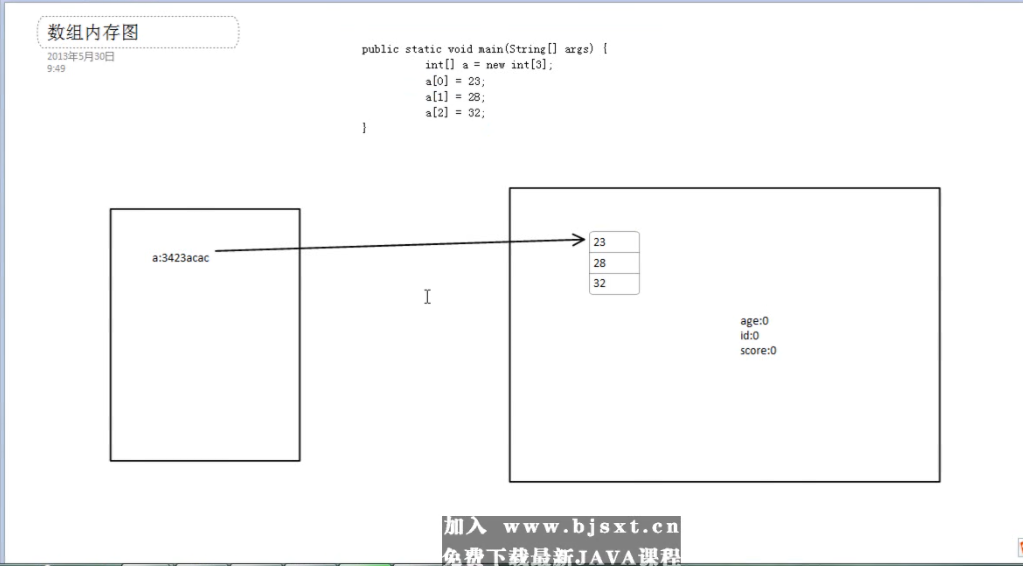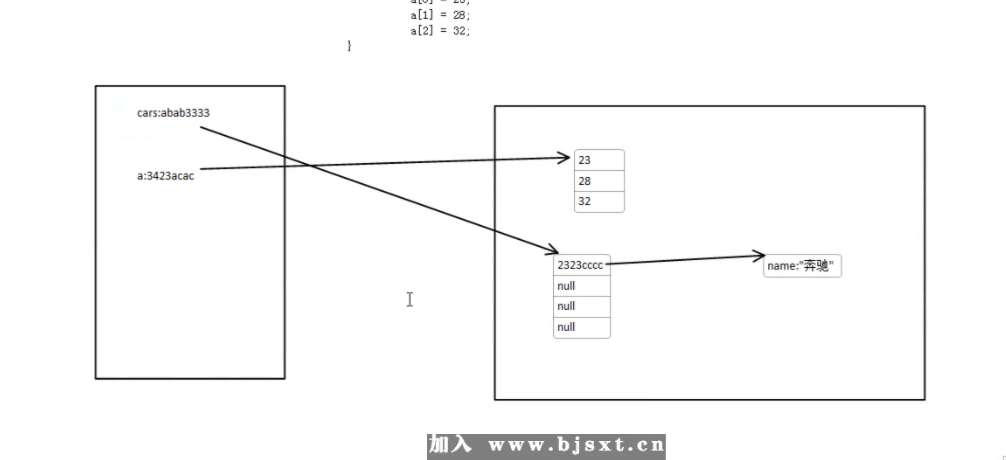


数组也是类: java类型有8种几本类型和引用类型,数组属于引用类型,数组也是对象。(通过new建出来的东西都在堆里面,int类型是4个字节),数组元素的初始值都为0,数组元素相当于对象的成员变量, int[] a; int b[]; //创建数组对象 a = new int[4]; b = new int[5]; //初始化(对数组元素的初始化) //默认初始化:数组元素相当于对象的成员变量,默认值跟成员变量的规则一样。数字0,布尔false,charu0000,引用:null //动态初始化: for(int i=0;i<a.length;i++){ a[i] = i*12; } //静态初始化 int c[] = {23,43,56,78}; //长度:4,索引范围:[0,3] Car[] cars = {//数组里面存的是一个个对象的地址,数组对象和数组里面的对象元素在堆中是分开放的。 new Car("奔驰"),//"奔驰"这个常量是在堆中方法区中的类信息区中的常量池中。 new Car("比亚迪"), new Car("宝马") }; Car c2 = new Car("奔驰");//每次new都会在堆中新建一个对象, System.out.println(c2==cars[0]);//false string类:equals比较值是否相等,=比较地址是否相等。 String str = new String("abcd"); String str2 = new String("abcd");//“abcd”也存在于类的常量池中, System.out.println(str2.equals(str)); //str和str2在栈中,指向不同的对象,true System.out.println(str2==str);//false System.out.println(str.charAt(2)); String str3 = "def";//存在常量池中 String str4 = "def";//共用上面那个常量池 System.out.println(str3.equals(str4));//true,str3和str4在栈中指向同一个常量池 System.out.println(str3==str4);//true final变量的值不能被修改,只有一个值, String gh = new String("a");//栈中gh的值(地址值)可以改,这个"a"字符串对象位于堆,他的属性private final char value[],这个char数组是不能改的,所以"a"这个对象不能改, for (int i = 0; i < 1000; i++) { gh = gh + i; } StringBuilder和StringBuffer: StringBuilder(线程不安全,效率高),StringBuffer(线程安全,有同步代码块,效率低),其余2者一样。String是不可变字符序列。StringBuilder、StringBuffer和String里面用的都是char数组。 try { throw new Exception(); //手动抛出一个异常 } catch (Exception e) { e.printStackTrace(); } ArrayList: 容器的底层实现很多是数组, package cn.bjsxt.myCollection; import java.util.ArrayList; /** * 模拟实现JDK中提供的ArrayList类 * @author dell * */ public class MyArrayList { /** * The value is used for object storage. */ private Object[] value; /** * The size is the number of objects used. */ private int size; public MyArrayList(){ this(10);//调用本类的构造函数 } public MyArrayList(int size){ if(size<0){ try { throw new Exception(); //手动抛出一个异常 } catch (Exception e) { e.printStackTrace(); } } value = new Object[size]; } public int size(){ return size; } public boolean isEmpty() { return size == 0; } public void add(Object obj){ value[size] = obj; size++; if(size>=value.length){ //装不下了。扩容吧! int newCapacity = value.length*2; Object[] newList = new Object[newCapacity]; // System.arraycopy(src, srcPos, dest, destPos, length); for(int i=0;i<value.length;i++){ newList[i] = value[i]; } value = newList; } } public Object get(int index){ rangeCheck(index); return value[index]; } public int indexOf(Object obj){ if(obj==null){ return -1; }else{ for(int i=0;i<value.length;i++){ if(obj==value[i]){ return i; } } return -1; } } public int lastIndexOf(Object obj){ if(obj==null){ return -1; }else{ for(int i=value.length-1;i>=0;i--){ if(obj==value[i]){ return i; } } return -1; } } public Object set(int index, Object object) { rangeCheck(index); Object old = value[index]; value[index] = object; return old; } public void rangeCheck(int index){ if(index<0||index>size-1){ //[0,size-1] try { throw new Exception(); //手动抛出一个异常。 讲到异常章节再说,先混个眼熟 } catch (Exception e) { e.printStackTrace(); } } } public static void main(String[] args) { MyArrayList list = new MyArrayList(2); list.add("aaa"); list.add(new Human("高琪")); list.add("bbbb"); list.add("bbbb"); list.add("bbbb"); list.add("bbbb"); ArrayList list2; Human h = (Human) list.get(1); System.out.println(h.getName()); System.out.println(list.get(3)); System.out.println(list.size()); Human h1 = new Human("啊啊"); Human h2 = new Human("啊啊"); System.out.println("----------------------"); System.out.println(h1==h2);//false System.out.println(h1.equals(h2));//false } } (冒泡排序,二分法查找) 多维数组: 数组中对象排序是按自己定义的compareTo方法排序(对象类中自己写),